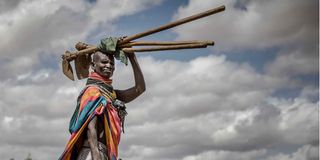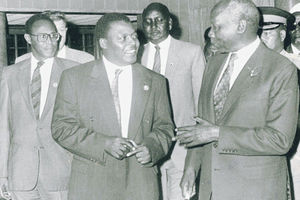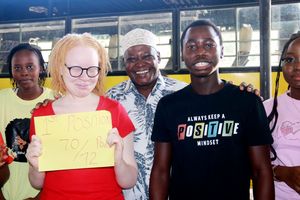Premium
An unforgettable flight to Lake Turkana

A Turkana woman carries farming tools on her way to her sorghum crops in an arid area in Nanyee, near Lodwar, Turkana County.
What you need to know:
- From Lake Turkana, we flew southeast, making for Koros Camp in the South Horr Valley in Marsabit County.
- Koros is a camp in the bush, a place with a special blend of rustic structures and luxurious service.
If I could have my time again, and if I had much more money than I have now, I would buy myself a helicopter – an Airbus H125 (A535OB3) – and I would learn how to fly it.
I had my first experience as a passenger a couple of weeks ago, and it was one of the most amazing thrills I have ever had. We explored some of the deserts, lakes, forests and mountains in northern Kenya in a way you couldn’t do by any other means.
By road you would never be able to reach where we went; by air in a fixed-wing aircraft you could only fly over – not in and through and down as we did. The small blue helicopter might have been made by Airbus, but it is nothing like a bus. It is as sleek as an F1 car and as agile as a cat.
Those of you who read last week’s article will know that we were having a most wonderful family treat – a day flight from Nanyuki to Lake Turkana and a second-day flight back via the Matthews Mountain Range. It was a birthday present from our older son, Andreas, who is a professional safari guide.
We had all spent the night in the 100-Year-Old House in Nanyuki, and at 6.45am we drove across the road to the airstrip and the hanger of Tropic Air, where our helicopter pilot, Tatiya ‘Tats’ Naikuni, was waiting for us. Tats comes from an aviation family. His father, Titus Naikuni, was CEO of Kenya Airways, and an uncle was the first Maasai to hold a pilot’s licence.
One day soon, I hope to tell Tats’ story. All I will say now is that he is a highly skilled helicopter pilot and one who has a fund of knowledge about the land and people we were flying to.
Dramatic rock formations
After take-off, Tats banked steeply over Ol Pejeta and we headed northwest over the Laikipia Plateau and the plains between Loisaba and Maralal. When we reached the Kerisia Hills, we flew west along their spine to the Rift Valley where we turned north along the Suguta Valley – the often fought-over boundary between Samburu and Turkana communities.
We then entered the rocky Hoodoo Valley, where Tats flew us low through a narrow and twisting gorge. It was like living a scene from Tom Cruise’s Top Gun: Maverick film. Once through the gorge, we landed for breakfast in a secluded spot surrounded by dramatic rock formations, where the hard, top layers of sedimentary rock were on softer layers, so some of them looked like big heads on lean bodies.
Overhead, a pair of fox kestrels were enjoying the thermals and, high in the distance, a rock kestrel cousin was approaching us. We then followed the Suguta River, over black lava flows and green pools, until we came to a lava field, across which sand dunes are blown – golden fold after golden fold. No one could live in this harsh terrain, but it has a stark beauty of its own.
We carried on up the Suguta River to Lake Logipi, following a seasonal river into a lake that has a dead end. Tats circled so that we could marvel at the sight of hundreds of thousands of flamingos feeding on the saline waters. We then landed on a lava field next to Andrew’s Volcano, which is just south of Lake Turkana. The Hungarian explorer, Count Teleki, was the first European to visit these wild parts. When he saw the volcano in 1888, it was erupting.
In the very south of Lake Turkana, we flew around the Nabiyotum Crater – a large caldera that is the remains of a collapsed volcano. I remember it from a scene in the film of the novel by John le Carré, The Constant Gardener. We then crossed the water to South Island, where we landed for a coffee break. We sat in the shade, and the energetic among us swam.
Camp in the bush
After that, we flew northeast and across the lake to just south of Loiyangalani, the very small township on the southeast coast of the lake. In Samburu, the name means ‘the place of many trees’, and it is a home for Rendille and El Molo people.
From Lake Turkana, we flew southeast, making for Koros Camp in the South Horr Valley in Marsabit County, where we would be spending the night. But on the way we landed to see the rock art site of Marti, where there are panels of paintings inscribed on a wall of basalt lava – paintings of animals and abstract figures that are said to be over 2,000 years old.
Koros is a camp in the bush, a place with a special blend of rustic structures and luxurious service. Re-launched in 2023 by Tropic Air and Amory Macleod’s Latitude Adventures, it is now the furthest north of ‘high-end’ accommodation in Kenya. As we landed, Amory welcomed us and led us through an acacia grove to the open and thatched mess building where he offered us drinks as we rested before a late and excellent lunch. Afterwards, some of the group went with Amory to the singing wells of the Samburu. One young man was heaving out water for his goats while singing. The rest of us rested in the tents, cooled by the open net sides and solar-powered fans.
In the evening, we had sundowners beside the pool which is at the highest point of the camp, and we enjoyed the parade of the planets in the night sky. At dinner, we had a long conversation with Amory, who has many stories to tell. The one that impressed me most was of the time, not so long ago, when Lewis Hamilton was there with his friends for a ride on quad bikes – a very fast ride along the sandy, twisting tracks.
And, talking of rides, you don’t need a helicopter to get there; you can reach there by road. The easiest way is via Isiolo and Laisamis, and there are directions in the Koros website, www.koroscamp.com
John Fox is Chairman of iDC Email: [email protected]





